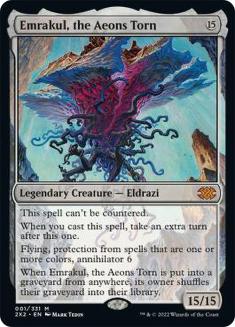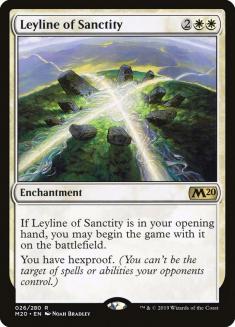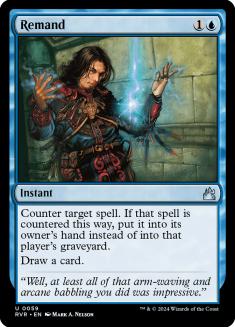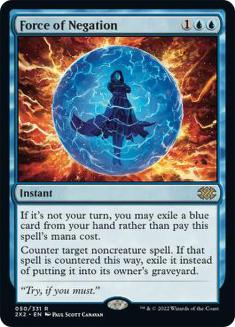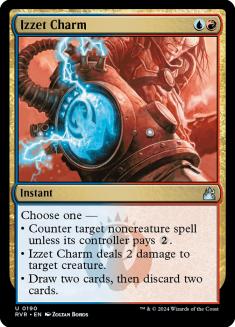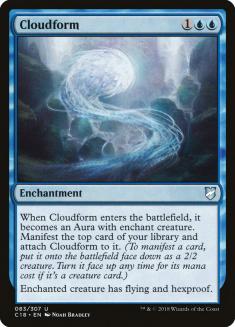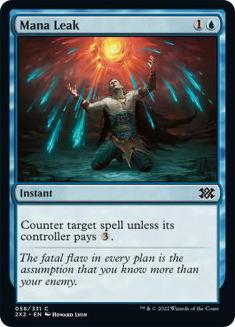Modern is the home of eccentricity, a competitive place where the brewers have the most freedom to create something special. I have been big into Commander as of late, and the uniqueness of that format is best replicated in Modern, especially after the recent bans. Uro, Titan of Nature’s Wrath made the format as stale as it gets, but now the deckbuilding limits continue to expand every week.
Combo is my passion, where control is my rock. I depend on control decks for my tournament success, as well as a landing spot best suited for my talents. I’m very good at piloting control decks and have been for a long time. Regardless of the format, or its strength in the metagame, the play patterns of control have not significantly varied over the years. Survival in the early-game, through Esper-colored disruption, has been more than just a brand for me. The control lifestyle has been consistently rewarding, but combo pries apart the icy grip control has over me in an instant.
I was curious about the number of combo decks I have played over the years in the competitive scene. A cool way to check: go to the Decks tab at the top of StarCityGames.com, click on any of the Deck Databases, search your name, and there it is! Each deck that you have a strong recorded finish with is there.
This trip down memory lane was an amazing experience for me. I relived some of the excitement I had when playing these wild combo decks once again, a much more riveting experience than Dimir Control at a random Grand Prix.
Flying to a Pro Tour in Paris, playing a deck like Mass Polymorph, and finishing the Constructed portion with a decent record was one experience that I had a strong connection with in my professional career. I got to see a similar deck finish a League a few weeks ago with a 5-0 record, immediately snagging my attention. My submission for What We’d Play in Modern was that gem.
Creatures (2)
Planeswalkers (4)
Lands (22)
Spells (32)
- 3 Lightning Bolt
- 2 Mountain
- 4 Serum Visions
- 4 Polymorph
- 4 Remand
- 2 Spell Snare
- 2 Izzet Charm
- 2 Anger of the Gods
- 2 Cloudform
- 4 Force of Negation
- 3 Transmogrify
Sideboard

The list you see here is not much different from the Magic Online 5-0 list, but I added some pieces to increase the consistency of the combo. This is a beautiful ode to the Polymorph strategies of old, producing some early-game disruption to increase the chances of the mid-game winning play being successful. Having a deck that’s completely dedicated to a fragile combo, like putting in a creature that needs to attack, without strong defenses around it is doomed to be unsuccessful.
What you see here is a Jeskai Control deck that happens to have a combo kill in it. The early-game is full of countermagic, removal, sweepers, and card draw, making it nearly identical to what you would see from a more traditional control strategy. The white is only in there for one card in the maindeck, Teferi, Time Raveler, which is brilliant deckbuilding for this combo.
Teferi, Time Raveler is the natural roommate of combo kills. There’s no other card you would want over it, since it locks the opponent out of any disruption on the turn you’re going for the throat. Emrakul, the Aeons Torn is a resilient monstrosity that handles most removal thrown at it.
The few spells that can deal with this resolved Eldrazi are null and void with a Teferi, Time Raveler on the battlefield anyway, as the combo can be executed at the end of the opponent’s turn: a simple fetch into a Dwarven Mine at end of turn, a Polymorph using the +1 of Teferi, and annihilator 6 to call it a day. I must continue to be reminded of Oko, Thief of Crowns because I want to give the G.O.A.T. status to my Azorius brother, but until Teferi, Time Raveler leaves Modern, it will protect combo players and boost control players against all foes.
The other white spells are in the sideboard and outline the most important disruption elements. Leyline of Sanctity is vital to the gameplan of Jeskai Polymorph. General protection from being targeted is great and it really pays dividends against black-based disruption. Resolving it against Mono-Red Prowess is fun, but landing one against decks with Thoughtseize can be lights out.
Rest in Peace is another hate card that is too powerful to pass up in Modern. The strength of graveyard-based strategies goes up as the format gets older, but this enchantment ages well. There still is not a deck that utilizes the graveyard that can overcome Rest in Peace when combined with other control elements. Having access to white opens these opportunities, including Stony Silence if artifacts ever have a resurgence in the format.
The last white card in the sideboard is Path to Exile. It was originally Chained to the Rocks, but the power level of the instant-speed removal far exceeds the negative of the opponent receiving a land. I’m sure the original pilot of the deck had their reasons, but I believe this change is for the better. The rest of the deck is a solid Izzet Control deck, with a strong defense apparatus to protect the Turn 4 combo at all costs.
I finally get to play a deck with Remand again, which is a huge pro that cannot be overlooked. Remand is a two-mana counterspell that draws a card and never gets used by control players. Each piece of disruption for a control deck needs to fully answer the threat, making cards that bounce an opponent’s card not ideal.
However, Remand is the best in that class of card and has a strong home in this combo deck. With the kill being a fetchland and a card with seven copies, the Turn 4 nature of Jeskai Polymorph is nearly a guarantee. It’s very unlikely to miss a piece of this by then, especially with the Serum Visions I added to the deck. Remand is basically a Time Walk, putting the threat back in the opponent’s hand, daring them to recast it with all their resources, and killing them with a Polymorph or Transmogrify the next turn. This is where it’s at its best and I have had a blast carrying that play pattern out during testing.
The other disruption spells have seen their fair share of control decks. Lightning Bolt, Anger of the Gods, Spell Snare, and Force of Negation provide a strong disruption package against the bulk of the metagame. Lightning Bolt handles the early-game drops with ease, while Anger of the Gods is a consistent sweeper to bail us out before a Turn 4 effective win.
As the format becomes more or less aggressive, the red-based removal numbers can shift accordingly. There are times where the number of Anger of the Gods in the maindeck needs to be higher than two, but I like the setup for now. The format is still finding its way and many players have settled back into big mana strategies. Having too many Lightning Bolts and Anger of the Gods against Mono-Green Tron is a bad time that I do not wish to have if it can be avoided. Luckily for us, the blue spells are pretty good there.
Force of Negation is an amazing spell, which has been obvious to control players from the start. It shines the most in combo decks because the punishment for an opponent tapping out is far worse. When control decks nail a noncreature spell with Force of Negation, the follow-up is a planeswalker at best. In Jeskai Polymorph, it’s an Emrakul, which is considerably stronger. Force of Negation is the best blue disruption Modern will ever have and may be the main reason a deck like this is viable.
I have gone back and forth on Spell Snare for good reason. It’s a very specific piece of disruption that banks on certain decks being popular over others. The biggest strength of Spell Snare is how it lines up against opposing disruption, helping push through a Polymorph or Transmogrify. It also fits the curve well, slowing down a two-drop in the cleanest fashion possible while also pitching to a Force of Negation. Some of my biggest tournament successes banked on the power of a Turn 1 Spell Snare, giving it a special place in my deckbuilding, but the format does have to cooperate to make it competitive.
Some pieces of Jeskai Polymorph are less traditional than others and need further explanation. Izzet Charm is a hot topic of debate for control and combo players throughout the years, with the consensus that it’s not very good. I tend to agree with the masses on this one; however, Jeskai Polymorph changes the accepted weakness of this card in a big way. The two most-used modes, counterspell and removal, have given it a home in some control and combo decks over the years. The draw-two, discard-two mode is generally a trap, giving Izzet Charm the allure of flexibility when there have been more effective spells in that category.
Jeskai Polymorph plays four Polymorph and three Transmogrify in the maindeck. This is the correct number, due to the Turn 4 requirement of this deck to be competitive in Modern. Unfortunately, these seven cards are terrible when drawn in multiples. There are some games where you must battle with disruption against the enemy’s disruption, a plan derailed by drawing three copies of the combo card. Izzet Charm offers an out to that, handling some disruption work while giving the controller a way to discard excess nonsense for some powerful blue cards. I like the card in this deck and the role it has played.
The last silly card is Cloudform and I would be shocked if most players knew what this card did without looking. I remember it as a Limited staple, producing a sweet flyer with upside for three mana. In Jeskai Polymorph, Cloudform is a desperate play the turn before, when the mana is not cooperating for a clean Dwarven Mine entry. There are also some scenarios where Cloudform bails you out, for example when the opponent can easily deal damage to the Dwarf token prior to the Polymorph sealing the deal. Cloudform prevents that fate with a most irritating keyword that I wish was not in the game.
Hexproof on Cloudform makes the combo very difficult to disrupt. If the opponent is not playing counterspells, this is one of the best routes to victory through traditional removal. It may feel silly to sleeve up, but Cloudform has that same additional benefit that I cannot stress enough. The blue cards in most Modern decks can be duds and still powerful, thanks to Force of Negation. This is just another line of insurance to handle some tricky wins while still having the out of serving a free counterspell.
Jeskai Polymorph may look like a combo deck with some silly cards, but it’s a control deck through and through. The sideboard has additional blue disruption with Mystical Dispute and Mana Leak, making the control feel even stronger against most matchups. Combine the usual blue suspects with traditional red and white removal, and Jeskai Polymorph can handle aggro, combo, control, and big mana decks as well as the rest in the early-game. Where it would tend to falter is the late-game, but it should never get to that point. The combo is as consistent as it gets, hits relatively early on Turn 4, and is very difficult to answer after resolution.
I’m excited to continue to play this deck to serve my combo desires and I hope that you all enjoy it as well.



